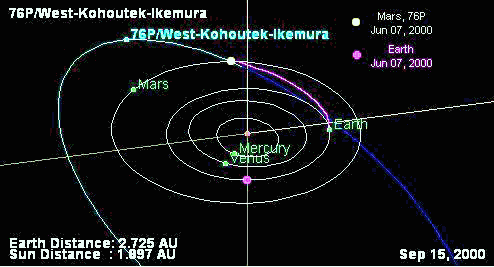
Subj: Re: 76P, 3 months to Earth
Date: 6/18/00 2:20:23 PM Pacific Daylight Time
Attached is my version of 76P slingshot arround Mars showing Mars-Earth-76P
positions on 06-07-2000 and 09-15-2000 as calculated by Astroarts
simulation
program.
Note that official orbit leg (blue) and that after slingshot dirrection
change (pink), drawn by me for 76P in this period are of comparable
lenthghs. This means that 76P can reach Earth position after approximately
3
months, arround mid-September, without any particular change in it's speed.
It si clear that such severe dirrection change must cause comet
fragmentation. This could explain it's invisibility.
It seems that the telemetry of Mars Global Surveyor spacecraft is
regurlarly
updated:
http://mpfwww.jpl.nasa.gov/mgs/jpl-telem/telem.html
If so, this rules out any Mars hit. The same can be deduced for Phobos
because of his extremly low orbit.
All the best.
IZAKOVIC
CROATIA

IN DEBATE
Date: 6/19/00 9:02:26 AM Pacific Daylight Time
From: jeckyll@dds.nl (Jeckyll)
Hi Kent,
Could you please revise on one of the links on your main page, because it'll
just cause unnecessary unrest
It is the link about TRAJECTORIES: 76P, 3 months to Earth
The information contained there, the drawing made by our Croatian friend
is FALSE. He made a wrong assumption to begin with. The blue part of the
trajectory is IN THE PAST, over, already travelled. The comet is moving to
the left and up in this picture, it came along the blue part.
So for the comet to get back to the position where Earth will be in three
months would require a U turn about the planet Mars. And that is SO unlikely,
that we may safely dismiss that. It won't follow the purple trajectory in
any case, that I dare to bet. This goes against celestial mechanics 101,
sorry. It would have to come within 1000 kms of Mars to be able to get half
way this. And that would lead to impact. It will just not make this trajectory.
NO WAY.
Suppose it would survive such a turn, it would fall straight into the Sun
if it were to lose so much of its speed when 'hair-pinning' Mars. Aside from
that it wouldn't just fall apart, but be converted into a ring of debris
around Mars sooner, it would be absolutely pulverized. We are talking a lot
of G forces here, not just a rollercoaster.
But just examine the orbit itself. It is not just a changing elliptical orbit
which is entered, it is also a reversal of direction along that! The chance
of that is just too small.
Any trajectory leading to impact would all but HAVE to pass by the left side
of the Sun in the above picture.
Regards,
Jacco